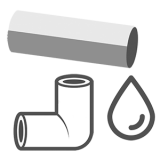| » » » |
Que recherchez-vous ?
The different types of media used in water filtration: everything you need to know!
Water filtration is a crucial step in ensuring the quality of drinking water. Water treatment facilities use different types of filtration media to remove impurities and contaminants from water. We offer different types of the most common filtration media. What are the different types of filtration media available and how do they work?
How to use media for the filtration of your drinking water?
If you are looking to filter water to make it drinkable, using bulk media can be an effective and economical solution, provided you know what contaminants you want to reduce or eliminate. There are two common ways to use bulk media for water filtration: fill empty Big cartridges if possible, or use bottles with a valve that will schedule your media to clean or regenerate when it becomes saturated.
Filling Empty Cartridges: Using Big 10 inch or 20 inch empty cartridges is an economical way to use bulk media to filter your home's water. You have the option of filling the cartridges with bulk media, such as activated carbon, sand, Birm or calcite, depending on the type of contaminants present in the water to be filtered. The cartridges can then be installed in filters specially designed for these Big cartridges. The main disadvantage is that we do not know when the media is saturated to replace it.
Using bottles: Another method of using bulk media to filter water is to use composite bottles. This method is the most economical, because once the equipment has been purchased, the media cannot be replaced for more years, even more than 10 years for some. Filter bottles containing bulk media are equipped with a mechanical or electronic valve to control the proper functioning of your filtration.
Before using bulk media to filter water, it is important to test the water in your area to determine what contaminants are present. Bulk media is specifically designed to remove certain types of contaminants, so it is important to choose the appropriate media for the specific contamination. Water analyzes are carried out by specialized laboratories for the quality of drinking water.
What are the most used filtration media?
Actived Charcoal :
Activated carbon is one of the most common filtration media used in water treatment facilities. It is made from organic materials such as coconut shells, olive pits, or hazelnut shells. Activated carbon is very effective in removing organic contaminants, chemicals, odors and unpleasant tastes from water. It is also used to remove residual chlorine present in water after treatment.
Sand :
Sand filtration is a water treatment method that removes suspended particles and treats turbidity in water. This water treatment method uses layers of pure sand of varying grain sizes to filter the water.
The sand used should be of high quality and free of contaminants to allow for effective filtration. Sand filtration is an inexpensive and easy-to-maintain water treatment method suitable for large-scale drinking water needs in developing countries. Sand filtration should be combined with other water treatment methods to provide superior drinking water.
KDF 55 or KDF 85:
KDF treatment is an innovative technology that improves drinking water treatment performance by effectively removing contaminants. Unlike traditional technologies which are often expensive, have a limited life and are difficult to maintain, KDF process fluids are economical, easy to use and have reduced material requirements. KDF media are high purity copper-zinc formulations that reduce contaminants in water using an oxidation/reduction (redox) reaction, thereby removing contaminants by converting them into harmless components. The micro-organisms are controlled by the electrolytic field created by the redox reaction and by the formation of radicals and peroxides. KDF treatment fluids can safely reduce or remove chlorine, hydrogen sulfide, heavy metals and bacteria from water. By using KDF racks, even fashion designers can remove chlorine from the municipal water used in their jeans washing process, demonstrating the versatility and simplicity of this innovative technology.
Birm:
Birm is a filtration media based on magnesium silicate. It is used to remove iron and manganese dissolved in water. Birm works by oxidizing ferrous and manganese ions so they can be easily trapped and filtered out. It is often used in combination with other filtration media to provide complete filtration.
Calcite:
Calcite is a natural mineral made from calcium carbonate. It is often used as a filtration medium to raise the pH of water and to remove acidity. Calcite is also useful for removing contaminants such as iron, manganese, and copper.
Pyrosulitis:
Pyrosulite is a filtration media that is used to remove heavy metals such as lead, copper, zinc and nickel. It is made from iron oxide and is often used in combination with other filtration media such as activated carbon to provide thorough filtration.
Bayoxide, Corosex and Green sand plus:
Bayoxide, Corosex and Green sand plus are filtration media based on magnesium oxide. They are used to remove hydrogen sulphide, iron, manganese and heavy metals dissolved in water. These filtration media are very effective in removing impurities from water, even at low concentrations.
In conclusion, there are a wide variety of filtration media used in water treatment facilities to remove contaminants and impurities. The five filtration media featured in this article are widely used in industry to provide premium drinking water. The choice of filtration media will depend on the contaminants present in the water to be treated and the water quality requirements for the end consumer.

































































